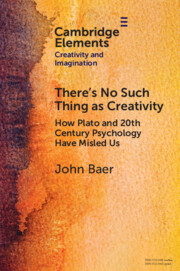67 results

There's No Such Thing as Creativity
- How Plato and 20th Century Psychology Have Misled Us
-
- Published online:
- 10 June 2022
- Print publication:
- 07 July 2022
-
- Element
- Export citation
12 - Domain-Specific Talent Development
- from Part III - Modes of Enhancement
-
-
- Book:
- The Cambridge Handbook of Lifespan Development of Creativity
- Published online:
- 19 November 2021
- Print publication:
- 25 November 2021, pp 265-277
-
- Chapter
- Export citation
Proliferation of Faulty Materials Data Analysis in the Literature
-
- Journal:
- Microscopy and Microanalysis / Volume 26 / Issue 1 / February 2020
- Published online by Cambridge University Press:
- 17 January 2020, pp. 1-2
- Print publication:
- February 2020
-
- Article
-
- You have access
- HTML
- Export citation
Chapter 2 - The Trouble with “Creativity”
-
-
- Book:
- The Nature of Human Creativity
- Published online:
- 01 May 2018
- Print publication:
- 19 April 2018, pp 16-31
-
- Chapter
- Export citation
Copyright page
-
- Book:
- The Cambridge Handbook of Creativity across Domains
- Published online:
- 15 September 2017
- Print publication:
- 28 September 2017, pp iv-iv
-
- Chapter
- Export citation
Part V - Newer Domains for Creativity Research
-
- Book:
- The Cambridge Handbook of Creativity across Domains
- Published online:
- 15 September 2017
- Print publication:
- 28 September 2017, pp 445-522
-
- Chapter
- Export citation
2 - The Amusement Park Theoretical Model of Creativity
- from Part I - Creativity and Domain
-
-
- Book:
- The Cambridge Handbook of Creativity across Domains
- Published online:
- 15 September 2017
- Print publication:
- 28 September 2017, pp 8-17
-
- Chapter
- Export citation
Part VI - Creativity in Everyday Life
-
- Book:
- The Cambridge Handbook of Creativity across Domains
- Published online:
- 15 September 2017
- Print publication:
- 28 September 2017, pp 523-632
-
- Chapter
- Export citation
Dedication
-
- Book:
- The Cambridge Handbook of Creativity across Domains
- Published online:
- 15 September 2017
- Print publication:
- 28 September 2017, pp v-vi
-
- Chapter
- Export citation
Contributors
-
- Book:
- The Cambridge Handbook of Creativity across Domains
- Published online:
- 15 September 2017
- Print publication:
- 28 September 2017, pp xii-xiv
-
- Chapter
- Export citation
Acknowledgments
-
- Book:
- The Cambridge Handbook of Creativity across Domains
- Published online:
- 15 September 2017
- Print publication:
- 28 September 2017, pp xv-xvi
-
- Chapter
- Export citation
Part I - Creativity and Domain
-
- Book:
- The Cambridge Handbook of Creativity across Domains
- Published online:
- 15 September 2017
- Print publication:
- 28 September 2017, pp 1-60
-
- Chapter
- Export citation
Part III - Creativity in the Sciences
-
- Book:
- The Cambridge Handbook of Creativity across Domains
- Published online:
- 15 September 2017
- Print publication:
- 28 September 2017, pp 197-322
-
- Chapter
- Export citation
35 - Taking a Prospective Look at Creativity Domains
- from Part VII - Conclusion
-
-
- Book:
- The Cambridge Handbook of Creativity across Domains
- Published online:
- 15 September 2017
- Print publication:
- 28 September 2017, pp 635-642
-
- Chapter
- Export citation
Part VII - Conclusion
-
- Book:
- The Cambridge Handbook of Creativity across Domains
- Published online:
- 15 September 2017
- Print publication:
- 28 September 2017, pp 633-642
-
- Chapter
- Export citation
Figures
-
- Book:
- The Cambridge Handbook of Creativity across Domains
- Published online:
- 15 September 2017
- Print publication:
- 28 September 2017, pp x-x
-
- Chapter
- Export citation
Index
-
- Book:
- The Cambridge Handbook of Creativity across Domains
- Published online:
- 15 September 2017
- Print publication:
- 28 September 2017, pp 643-668
-
- Chapter
- Export citation
1 - Creativity Across Different Domains
- from Part I - Creativity and Domain
-
-
- Book:
- The Cambridge Handbook of Creativity across Domains
- Published online:
- 15 September 2017
- Print publication:
- 28 September 2017, pp 3-7
-
- Chapter
- Export citation
Contents
-
- Book:
- The Cambridge Handbook of Creativity across Domains
- Published online:
- 15 September 2017
- Print publication:
- 28 September 2017, pp vii-ix
-
- Chapter
- Export citation
Part IV - Creativity in Business
-
- Book:
- The Cambridge Handbook of Creativity across Domains
- Published online:
- 15 September 2017
- Print publication:
- 28 September 2017, pp 323-444
-
- Chapter
- Export citation



